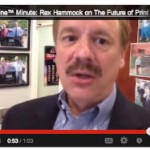



The current Idea Email explains how and why ad-blocking isn’t just a browser plug-in hack. Blocking ads is also a multi-billion dollar business. It’s based on the notion that advertising doesn’t always need to be at the transaction intersection when dollars are exchanged for content. Oftentimes, customers become so overwhelmed by the crush of ads on the internet and traditional media, they are more than willing to pay media companies for the chance to view (listen to, watch, read) ad-free content.
And many media companies have learned that there are billions of dollars in potential revenue in allowing people to pay for ad-free content, rather than subjecting them to personalized ads or the sheer magnitude of ads that appear on a web page.
Here are some examples of ad-free content providers and how they make money (or hope to).

Anyone who has read this blog with any consistency or subscribes to Hammock’s Idea Email will understand why I think the article “A mile wide, an inch deep” written by Medium.com founder and Twitter co-founder Ev Williams should be required reading for marketers.
 In November, 2012, we titled our very first Idea Email with a line inspired by the sentence Apple used to introduce the second generation of the iPad: “Technology at its very best is invisible.”
In November, 2012, we titled our very first Idea Email with a line inspired by the sentence Apple used to introduce the second generation of the iPad: “Technology at its very best is invisible.”
In our version, we substituted “marketing” for the word technology.
In that first Idea Email, we wrote what we still believe to be the goal of great marketing:
The goal of great marketing should be to make the customer smarter, stronger, happier, or whatever the customer wants when they purchase a product or join an association or sign up for a service. When you emphasize how your product can help customers achieve something, they don’t think of it as marketing. They think of it as help. And that’s when marketing is at its very best.
Jeff Cornwall, Belmont University entrepreneurship professor and longtime blogger (The Entrepreneurial Mind), recently invited Rex Hammock to appear on the video version of his blog — a show produced by the Nashville-based web video network, Talkapolis. In the 10 minute episode, Rex explains the customer media and content focus of Hammock Inc. — and our role in the context of today’s marketing landscape.


It is almost a cliché for billionaires to make vanity purchases of media companies and professional sports franchises (indeed, Henry owns several).
In this case, however, the two billionaires have track records of revolutionizing industries by applying a unique formula that seems especially suited for helping traditional (venerable) media companies (and all companies) respond to the challenges (and opportunities) they face today. First, in their previous endeavors, they have obsessively searched for a means to understand and master the metrics that matter most in a particular marketplace; and second, they have passionately pursued a never-ending quest for insight into, and response to, the needs and desires of customers.
For marketers, this presents both challenges and opportunities.

Credit: ThinkStock
The current Hammock Idea Email points out the folly of investing in tactics advocated by those who promise they can magically improve the way Google ranks a company’s website. “You’ll never out-smart Google, so stop trying,” we advise.
Overtime, the only way to influence Google’s ranking is to, first and foremost, have a great product or service. Then follow Google’s guidelines and recommendations rigorously. This means, create a website filled with the most helpful, insightful information your customers look for related to the market niche your company serves.
With the release of the fourth version of Google’s war on link spam, an upgrade to the company’s algorithm they are calling Penguin 2.0, the message is clear: Try to outsmart Google and you’ll likely be penalized in the future.
There are dozens, make that hundreds, of things you can do to improve your site’s findability. Here are just five things you can do to make your site Pengiun 2.0-friendly:
Recognizing the customers’ ultimate objective isn’t to buy pots and pans but to become better cooks, Williams-Sonoma elevated the role of customer media and content, making it a part of the brand’s core mission.
In the current issue of The Idea Email, we explain why we’re inspired by how the retailer Williams-Sonoma has made the creation and use of customer media and content a part of their mission statement.
Here are three of our favorite ways they display their commitment to “helping customers become great cooks” in a way that adds value to the cookware they sell. (We could have added lots more.)
 The Sous-Chef-Series: Williams-Sonoma has partnered with The Tasting Table for a free weekly email and website series featuring the stories of up-and-coming chefs from around the U.S. Why we like it: Great stories and recipes are coupled with Williams-Sonoma cookware that’s related to the dish being shared. A great example of “content-enabled commerce.”
The Sous-Chef-Series: Williams-Sonoma has partnered with The Tasting Table for a free weekly email and website series featuring the stories of up-and-coming chefs from around the U.S. Why we like it: Great stories and recipes are coupled with Williams-Sonoma cookware that’s related to the dish being shared. A great example of “content-enabled commerce.”
 While Rex Hammock was in Oxford, Mississipi earlier this week (see previous post), Mr. Magazine Samir Husni interviewed Rex and posted a couple of “Mr. Magazine Minutes”–Rex’s answers to a couple of questions.
While Rex Hammock was in Oxford, Mississipi earlier this week (see previous post), Mr. Magazine Samir Husni interviewed Rex and posted a couple of “Mr. Magazine Minutes”–Rex’s answers to a couple of questions.
On his blog, Professor Husni wrote:
“You can call Rex Hammock, the founder and chief executive officer of the Nashville-based Hammock Inc., any name you want, except that of a Luddite. Rex bought his first Apple Mac in 1984, and has been tempted by the Apple ever since. On Twitter he is simply known as @R. He is all over the web, the digital sphere and more.
So when Rex came to speak to my magazine students at the Meek School of Journalism and New Media yesterday, I seized the opportunity to ask him two questions, after he completed his presentation to the students.
Here are Rex’s two Mr. Magazine minute videos. (If you are on the front of the Hammock Blog, click through to see the videos)